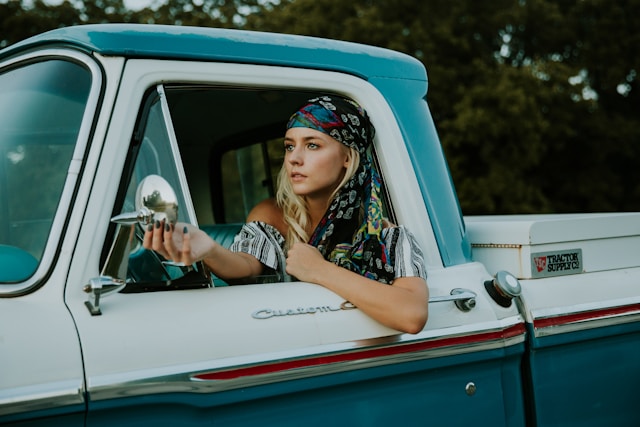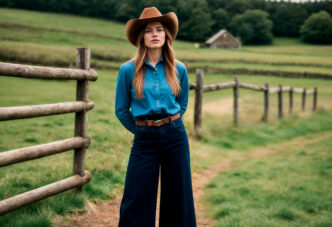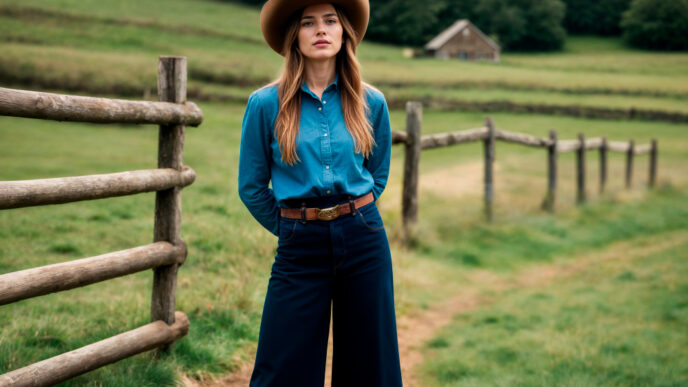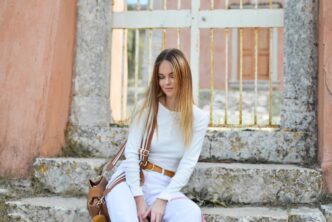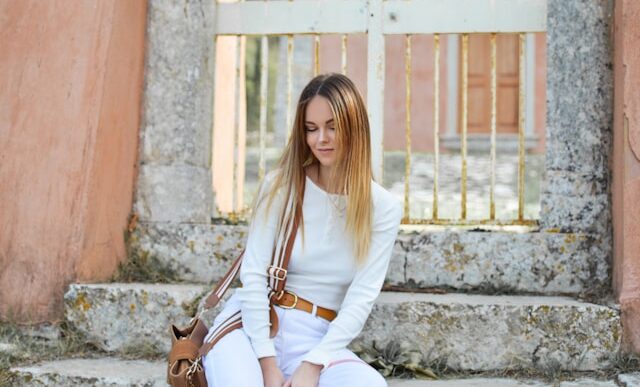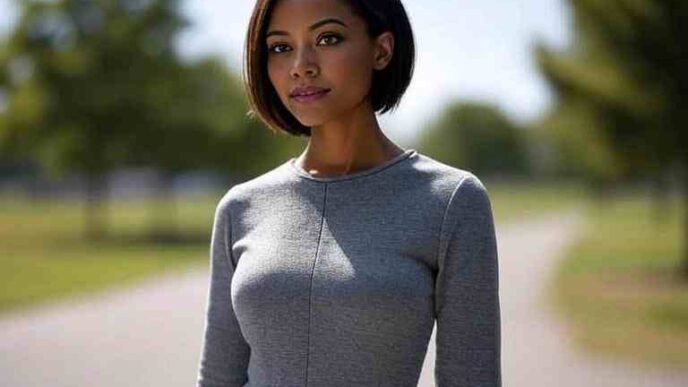Bandanas have become essential accessories in modern fashion. These squares of fabric offer endless styling possibilities. Learning how to style bandana pieces creates fresh looks for any wardrobe. This guide covers practical ways to wear these versatile accessories. You will discover combinations that work for casual days and special events. The article explores different styles and provides clear advice for every season.
Top 10 Bandana Outfit Ideas
Bandanas create excellent accent pieces for many different looks. Their versatility allows creative styling approaches across seasons. These ideas show various ways to incorporate this accessory into your daily outfits.
Bandana with Denim Jacket
A classic bandana worn around the neck transforms a simple denim jacket into a statement piece. This combination works perfectly for casual outings and weekend activities. The contrast between the structured jacket and flowing fabric creates appealing visual interest.
Choose bandanas in colors that complement your denim wash. Red or navy bandanas work beautifully with light denim, while cream or yellow options pair well with darker washes. The size should be appropriate for comfortable neck wear without overwhelming your frame.
Fold the bandana diagonally to create a triangle, then roll it loosely from the long edge. Tie it around your neck with the knot positioned to one side for asymmetrical appeal. This bandana outfit for women works well with white tees, fitted tanks, or simple blouses underneath the jacket.
Complete the look with comfortable jeans or casual pants in complementary colors. The bandana adds personality without overwhelming the overall aesthetic. White sneakers or ankle boots work well to maintain the relaxed nature of this combination.
This styling approach demonstrates how small accessories can elevate basic pieces. The bandana brings color and texture to simple outfits while maintaining comfortable wearability for everyday activities and casual social events.
Bandana with White Button-Down
A sophisticated bandana worn as a neckerchief elevates a crisp white button-down shirt. This combination bridges professional and casual styling perfectly. The polished shirt provides structure while the bandana adds personality and visual interest.
Select silk or cotton bandanas in refined patterns for this elevated styling approach. Navy with white paisley, burgundy with gold accents, or classic polka dots work beautifully for professional casual environments. The fabric quality should complement the shirt’s crispness.
Fold the bandana into a narrow strip and tie it loosely around your neck, allowing the ends to drape naturally. Position the knot slightly off-center for modern appeal. This bandana outfits technique works well with both long and short sleeve button-downs.
Layer with tailored blazers for business meetings or wear alone for smart casual occasions. The bandana transforms the traditional button-down into something more personal and stylish while maintaining appropriate professionalism.
Pair with tailored trousers, pencil skirts, or dark denim depending on the formality level desired. This combination shows how classic accessories can modernize traditional wardrobe staples effectively.
Bandana with Summer Dress
A bandana worn as a head wrap creates bohemian charm with flowing summer dresses. This combination works beautifully for outdoor events and warm weather activities. The fabric adds texture while providing practical sun protection for your hair.
Choose lightweight cotton bandanas in colors that complement your dress palette. Floral patterns work well with solid dresses, while geometric prints pair beautifully with simple florals. The size should provide adequate coverage without creating bulk.
Fold the bandana diagonally and place it over your head with the fold at your forehead. Tie the ends at the nape of your neck, allowing some hair to show for softness. This women’s bandana outfits approach works with both casual sundresses and more structured day dresses.
The styling creates effortless vacation vibes that work for beach days, farmers markets, or outdoor concerts. Add comfortable sandals and a crossbody bag to complete the relaxed aesthetic that emphasizes comfort and style.
This combination demonstrates how accessories can transform simple dresses into statement outfits while providing practical benefits like sun protection and hair management during outdoor activities.
Bandana with High-Waisted Jeans
A bandana worn as a belt creates unique waist definition with high-waisted jeans. This innovative styling approach adds color and texture while emphasizing the silhouette. The fabric provides flexible fit that adjusts throughout the day.
Select medium to large bandanas in sturdy cotton fabrics that hold their shape when tied. Bold prints or solid colors work well depending on your style preferences. The bandana should be long enough to tie comfortably around your waist with some drape.
Fold the bandana diagonally into a long strip and thread it through your belt loops like a traditional belt. Tie it at your natural waist with a bow or knot, allowing the ends to hang naturally. This how to style bandana technique works particularly well with fitted or cropped tops.
The styling creates bohemian flair that works for music festivals, art fairs, or casual social gatherings. The bandana belt adds personality while serving the functional purpose of defining the waistline and creating flattering proportions.
Pair with fitted tees, crop tops, or tucked blouses to showcase the bandana belt effectively. This combination shows creative ways to use traditional accessories in unexpected applications for modern styling approaches.
Bandana with Casual T-Shirt
A bandana tied around the wrist creates subtle accent styling with basic t-shirts. This simple approach adds color without overwhelming casual outfits. The wrist placement provides easy visibility while remaining understated and comfortable.
Choose smaller bandanas or fold larger ones into narrow strips for wrist wear. The fabric should be soft enough for comfortable skin contact throughout the day. Colors can either complement or contrast with your t-shirt depending on desired impact.
Fold the bandana into a thin band and tie it loosely around your wrist, allowing for comfortable movement. The knot should be secure but not tight. This how to wear bandana method works well with both short and long sleeve tees.
This subtle styling approach works for any casual occasion where you want to add personality without creating dramatic fashion statements. The bandana provides color interest while maintaining the relaxed nature of t-shirt outfits.
Complete the look with comfortable jeans, shorts, or casual pants depending on the season and activity. This demonstrates how small touches can personalize basic wardrobe pieces effectively without requiring major styling commitments.
Bandana with Blazer
A bandana worn in the breast pocket of a blazer creates sophisticated accent styling. This approach works beautifully for business casual and creative professional environments. The fabric adds personality while maintaining appropriate professional polish.
Select silk or fine cotton bandanas in refined patterns that complement your blazer color. Small paisley prints, subtle florals, or geometric patterns work well for professional settings. The colors should coordinate with your overall outfit palette.
Fold the bandana into a neat square with interesting pattern elements visible above the pocket edge. The display should appear intentional but not excessive. This types of bandana for women styling works with both structured and relaxed blazer styles.
The technique transforms standard blazers into personalized statement pieces while maintaining professional appropriateness. The bandana adds visual interest and demonstrates attention to styling details that enhance overall outfit sophistication.
Pair with tailored trousers, pencil skirts, or appropriate dresses depending on your workplace dress code. This styling shows how traditional accessories can enhance professional wardrobes with personality and polish.
Bandana with Off-Shoulder Top
A bandana worn as a choker complements off-shoulder tops beautifully. This combination creates balanced visual weight while adding texture around the neckline. The fabric provides soft contrast to exposed shoulder areas.
Choose bandanas in colors that complement your skin tone and top color. The size should be appropriate for comfortable neck wear without creating bulk or restriction. Lightweight fabrics work best for this delicate styling approach.
Fold the bandana into a narrow band and tie it snugly but comfortably around your neck. Position the knot at the back for clean front presentation. This what to wear with bandana technique works particularly well with romantic and feminine top styles.
The styling creates bohemian elegance that works for date nights, casual dinners, or social events where you want to appear effortlessly stylish. The bandana adds personality while enhancing the romantic nature of off-shoulder styling.
Complete the look with flowing skirts, fitted jeans, or tailored pants depending on the occasion. This combination demonstrates how accessories can enhance existing style elements in clothing for cohesive overall presentations.
Bandana with Ponytail
A bandana woven through a ponytail creates playful texture and color in simple hairstyles. This styling works perfectly for active days when you need hair management with personality. The fabric adds visual interest while serving practical purposes.
Select bandanas in colors that complement your hair color and outfit palette. The fabric should be smooth enough to slide easily through hair without catching or pulling. Medium sizes work best for most ponytail applications.
Create your ponytail at desired height, then fold the bandana into a long strip. Weave it over and under sections of the ponytail, securing the ends with small elastic bands or by tying them together. This bandana outfit ideas for women approach works with both high and low ponytails.
The technique creates casual charm perfect for outdoor activities, casual work environments, or weekend social events. The bandana adds color while keeping hair neat and styled throughout active days.
This styling demonstrates practical applications for accessories that combine function with fashion appeal. The bandana serves hair management needs while adding personality to simple hairstyles.
Bandana with Cardigan
A bandana draped over the shoulders under an open cardigan creates layered texture and color. This sophisticated approach works well for transitional weather when light layering becomes necessary. The fabric adds visual interest without bulk.
Choose bandanas in colors that coordinate with both your cardigan and base layer colors. The pattern should complement rather than compete with other outfit elements. Lightweight fabrics drape best for this application.
Drape the bandana over your shoulders like a small scarf, then layer the cardigan over it. Allow portions of the bandana to show at the neckline and sleeve openings for subtle color pops. This how to dress up bandana technique works with both casual and dressy cardigans.
The styling creates sophisticated layering that works for office environments, casual dinners, or social events where polished casual appearance is appropriate. The bandana adds personality while maintaining refined overall presentation.
Pair with appropriate base layers and bottoms depending on the occasion and season. This demonstrates advanced layering techniques that incorporate accessories for enhanced visual interest and style sophistication.
Bandana with Hat
A bandana tied around a hat band creates coordinated western or bohemian styling. This combination works beautifully for outdoor events and festival styling. The bandana adds color while coordinating accessories for cohesive presentation.
Select bandanas that complement your hat color and style. Traditional paisley prints work well with western hats, while geometric patterns suit fedoras or panama styles. The bandana should be long enough to tie comfortably around the hat band.
Remove the existing hat band if present, then tie the folded bandana around the crown at the desired position. Create a simple knot or bow depending on your style preference. This bandana style tips approach works with various hat styles and occasions.
The styling creates personality-driven looks perfect for outdoor concerts, farmers markets, or vacation activities. The coordinated accessories demonstrate thoughtful styling attention that elevates casual outfits.
Complete the look with appropriate clothing that maintains the overall aesthetic whether western, bohemian, or casual contemporary styling direction you prefer for different occasions and personal expression.
Types and Styles of Bandanas
Understanding different bandana options helps you select pieces that work best for your styling needs and personal preferences. Modern bandanas come in various materials, sizes, and patterns that accommodate different applications and aesthetic goals.
Traditional cotton bandanas remain the most versatile and widely available option for most styling applications. These typically measure 22 inches square and feature classic paisley prints in various color combinations. The cotton fabric provides durability while maintaining softness for comfortable wear against skin.
Classic red paisley bandanas offer timeless American styling that works with denim, western wear, and casual outfits. Navy versions provide sophisticated alternatives that coordinate well with neutral clothing colors. These traditional options work for both functional and fashion applications.
Silk bandanas provide luxury alternatives with smoother textures and refined drape qualities. The natural sheen adds elegance that works well for professional environments and dressy casual occasions. Silk options typically feature more sophisticated patterns and color palettes than cotton alternatives.
The smooth texture of silk makes these bandanas ideal for neck wear and hair applications where comfort against skin becomes important. Care requirements include gentle washing or dry cleaning to maintain appearance and texture quality over time.
Large format bandanas, measuring 27 inches or more, provide additional styling versatility for applications requiring more fabric coverage. These work well as head wraps, belt alternatives, or decorative draping where standard sizes might prove insufficient for desired aesthetic effects.
The larger size accommodates various folding and tying techniques while providing adequate coverage for practical applications like sun protection or hair management during outdoor activities and travel situations.
Small bandanas, typically 16 inches square, work well for delicate styling applications where standard sizes might appear overwhelming. These suit wrist wear, small neck accents, or decorative pocket applications where subtle touches provide desired visual interest.
The compact size makes these options ideal for petite frames or minimal styling approaches where accessories should enhance rather than dominate overall outfit presentations and personal style expressions.
Printed bandanas feature various pattern options beyond traditional paisley designs. Floral prints offer feminine alternatives that work with romantic and bohemian styling approaches. Geometric patterns provide contemporary appeal for modern outfit applications.
Animal prints, polka dots, and abstract designs expand styling possibilities while maintaining the classic bandana silhouette and functionality. Pattern selection should coordinate with personal style preferences and intended outfit applications for best results.
Solid color bandanas provide versatile options that coordinate easily with patterned clothing and various color schemes. These work particularly well when you want texture and functionality without competing pattern elements in already complex outfit combinations.
Neutral colors like navy, black, white, and brown provide maximum coordination flexibility while brighter options add personality and seasonal appeal to various styling applications and personal expression goals.
Custom and designer bandanas offer unique patterns and premium materials for those seeking distinctive styling options. These might feature original artwork, luxury fabric blends, or limited edition designs that create signature looks.
While typically more expensive than standard options, custom pieces can provide unique styling elements that reflect personal taste and create memorable fashion statements for special occasions and individual expression.
Vintage and reproduction bandanas offer historical styling elements that work with retro and authentic period looks. These might feature traditional railroad or cowboy patterns that provide authentic western styling for themed events or personal aesthetic preferences.
The historical elements add authenticity to period-inspired outfits while providing functional accessories that serve both practical and fashion purposes in contemporary styling applications.
How To Choose The Best Bandana
Selecting the right bandana requires consideration of intended use, personal style preferences, and quality factors that ensure satisfaction and versatility. The decision process should account for both aesthetic and practical applications you plan for the accessory.
Start by determining your primary intended uses for the bandana. Fashion applications require different considerations than functional uses like dust protection or hair management. Understanding your priorities helps narrow options effectively.
Fashion-focused selections emphasize appearance factors like pattern, color coordination with existing wardrobe pieces, and fabric quality that photographs well and maintains appearance through regular wear and cleaning cycles.
Consider the fabric options that work best for your intended applications and skin sensitivity requirements. Cotton provides durability and easy care for frequent use, while silk offers luxury and refined appearance for special occasions and professional environments.
Synthetic blends might offer specific benefits like moisture-wicking for active applications or wrinkle resistance for travel situations. Understanding fabric properties helps ensure satisfaction with performance and maintenance requirements over time.
Evaluate size requirements based on your styling preferences and physical proportions. Standard 22-inch squares work for most applications, while larger options provide versatility for creative styling techniques and fuller coverage applications.
Smaller sizes suit delicate styling approaches and petite frames where standard sizes might appear overwhelming. Consider trying different sizes to understand what proportions work best for your preferred styling approaches.
Assess pattern and color options that coordinate with your existing wardrobe colors and personal style aesthetic. Classic patterns provide timeless appeal, while contemporary designs offer current fashion relevance for trend-conscious styling.
Color selection should complement your skin tone and hair color while providing versatility for multiple outfit combinations. Neutral options maximize coordination possibilities while bold colors create statement effects for personality-driven styling.
Consider quality indicators that predict durability and maintained appearance through regular use and cleaning. Well-finished edges, colorfast dyes, and appropriate fabric weight indicate quality construction that justifies investment in versatile accessories.
Check care requirements to ensure they align with your maintenance preferences and available time for proper accessory care. Some materials require special handling that might not suit busy lifestyles or travel situations.
Seasonal Style Guide for Bandanas
Bandanas adapt beautifully to seasonal styling changes with appropriate color and application adjustments. Understanding seasonal approaches ensures year-round versatility while maintaining style appropriateness for different weather conditions and fashion expectations.
Spring styling emphasizes fresh colors and lightweight applications that complement the season’s renewal energy. Pastel bandanas in soft pinks, mint greens, or lavender create feminine touches that coordinate with spring wardrobes and outdoor activities.
Floral patterns work particularly well during spring months, echoing garden themes and natural renewal that characterizes the season. These coordinate beautifully with both solid colors and subtle patterns in clothing while adding personality to transitional weather outfits.
Spring applications focus on hair accessories and neck wear that provide light coverage while adding visual interest. The bandana can protect hair during windy spring days while contributing color and pattern to otherwise neutral transitional wardrobes.
Layer spring bandanas with light cardigans, denim jackets, or blazers for temperature flexibility as weather conditions change throughout the day. The accessories provide personality touches that enhance seasonal styling approaches.
Summer styling maximizes practical benefits while maintaining fashion appeal during hot weather conditions. Lightweight cotton or silk bandanas provide sun protection for hair and neck areas while adding style to minimal summer wardrobes.
Bright colors and bold patterns suit summer’s energetic atmosphere while providing visibility during outdoor activities and vacation settings. Red, navy, and tropical prints work well for beach environments and festival styling approaches.
Head wrap applications become particularly practical during summer months, protecting hair from sun damage while creating bohemian styling that suits casual summer activities and travel situations where hair management becomes important.
Summer bandanas coordinate well with sundresses, shorts, and tank tops while providing functional benefits that enhance outdoor comfort and style simultaneously for active warm weather lifestyles.
Autumn styling allows richer colors and more sophisticated applications that complement the season’s mature aesthetic. Deep burgundy, forest green, and gold bandanas coordinate beautifully with autumn’s natural color palette and heavier clothing textures.
Traditional paisley patterns in earth tones suit autumn’s classic styling approaches while providing timeless appeal that works with both casual and professional autumn wardrobes and seasonal activities.
Autumn applications include layering with sweaters, blazers, and scarves for complex textural combinations that create visual interest during months when clothing becomes more substantial and layered for temperature control.
The accessories work well with boots, structured bags, and other autumn accessories that emphasize craftsmanship and traditional styling elements that characterize seasonal fashion approaches.
Winter styling focuses on color coordination with deeper seasonal palettes while providing practical benefits during harsh weather conditions. Dark colors like navy, burgundy, and black coordinate well with winter clothing while maintaining sophisticated appearances.
Rich patterns in appropriate colors add personality to winter outfits that might otherwise appear monotonous due to heavy layering requirements and limited color options during cold weather months.
Winter applications emphasize neck wear that provides additional warmth layers while maintaining style appeal. The bandana can layer under coats and scarves for extra protection while adding color close to the face.
Coordinate winter bandanas with appropriate outerwear colors and textures for cohesive seasonal styling that maintains personality and style appeal despite practical weather requirements and heavy clothing necessities.
Do’s and Don’ts of Wearing Bandanas
Understanding proper bandana styling principles helps create polished looks while avoiding common mistakes. These guidelines ensure your accessory enhances rather than detracts from overall outfit presentation and personal style goals.
Do choose bandana sizes appropriate for your intended application and body proportions. Standard sizes work well for most styling applications, while oversized options might overwhelm petite frames or create unflattering proportions with certain outfit combinations.
Proper sizing ensures comfortable wear while maintaining visual balance with other outfit elements. The bandana should enhance your appearance rather than dominating the overall aesthetic or creating awkward proportional relationships.
Consider how the bandana size relates to your hairstyle, neck length, and facial features when selecting options for head or neck wear applications. Proportional harmony creates more flattering and polished overall presentations.
Do coordinate bandana colors and patterns with your existing outfit elements and personal color palette. The accessory should complement rather than clash with other colors and patterns in your ensemble for cohesive appearance.
Successful color coordination creates intentional looks that appear well-planned rather than accidentally assembled. Consider undertones and intensity levels when combining colors for harmonious overall presentations that enhance your natural coloring.
Pattern mixing requires careful consideration to avoid overwhelming visual competition. Generally, pair patterned bandanas with solid clothing or choose patterns that share similar scale and color elements for successful combinations.
Do maintain clean and well-cared-for bandanas that present professionally and attractively. Proper laundering and storage ensure accessories maintain their appearance and contribute positively to overall outfit presentation and personal grooming standards.
Quality maintenance demonstrates attention to detail that enhances overall style credibility and personal presentation. Clean, pressed accessories show respect for both the accessory and the people you encounter throughout your day.
Store bandanas properly to prevent wrinkles and maintain shape for best appearance when worn. Proper care extends accessory life while ensuring consistent quality presentation across various styling applications and occasions.
Do experiment with different styling techniques to discover applications that work best for your lifestyle and aesthetic preferences. Practice various folding and tying methods to build confidence and skill with bandana styling approaches.
Experimentation helps develop personal styling signatures while building comfort with accessory use in various social and professional contexts. Start with simple applications and progress to more complex techniques as comfort develops.
Don’t wear bandanas in inappropriate settings where the casual nature might conflict with dress code requirements or social expectations. Very formal business environments or black-tie events typically require more sophisticated accessory choices.
Understanding context appropriateness ensures your styling choices support rather than undermine professional goals and social success in various environments and situations where appearance impacts outcomes.
Consider workplace culture and event formality when deciding whether bandana styling suits specific occasions and professional requirements for optimal social and career success.
Don’t ignore personal comfort and practical considerations when styling bandanas for extended wear periods. Accessories should enhance rather than create discomfort or distraction during daily activities and professional responsibilities.
Comfortable styling ensures you can focus on important activities rather than adjusting uncomfortable accessories throughout the day. Proper fit and appropriate application methods prevent discomfort and styling failures.
Test new styling approaches during low-stakes situations before wearing them to important events or professional settings where styling failures could create negative impressions or personal discomfort.
Don’t overwhelm simple outfits with excessive bandana styling or multiple accessories that compete for attention. Successful accessory use enhances existing outfit elements rather than dominating overall presentation through excessive decoration.
Restraint in accessory application demonstrates style sophistication and understanding of proportion balance that creates more polished and professional overall appearances for various social and professional contexts.
Focus on one primary bandana application per outfit rather than multiple competing elements that might create cluttered or overwhelming visual presentations that detract from overall style effectiveness.
Don’t neglect proper hygiene considerations when wearing bandanas in direct contact with skin or hair. Clean accessories prevent skin irritation and maintain professional appearance standards essential for social and professional success.
Regular washing prevents odor retention and bacteria buildup that could create health issues or unpleasant social situations. Maintain multiple clean bandanas for regular rotation in frequent styling applications.
Consider skin sensitivity when selecting fabric types for direct contact applications. Some individuals require natural fibers to prevent allergic reactions or skin irritation that could compromise comfort and appearance.
8 Tips on How to Wear Bandanas
Mastering bandana styling requires understanding versatile application techniques that work across different occasions and personal style preferences. These essential tips help maximize styling potential while maintaining appropriate and polished presentations.
The first tip focuses on mastering basic folding techniques that create different styling effects and size adjustments for various applications. Understanding fold variations provides flexibility for different styling needs and aesthetic goals.
The triangle fold works well for head wraps and neck styling, creating pointed edges that add visual interest. The strip fold creates narrow bands perfect for wrist wear, belt applications, or delicate neck styling that provides subtle accent effects.
Practice different folding methods to build confidence and skill with bandana manipulation. Consistent folding creates neater presentations that appear professional and intentional rather than hastily assembled or accidental in execution.
The second tip emphasizes color coordination principles that create harmonious outfit combinations while avoiding clashing or competing visual elements. Understanding color relationships helps ensure successful bandana integration into existing wardrobes.
Complementary colors create vibrant contrast that energizes outfits while analogous colors provide subtle harmony that enhances overall aesthetic cohesion. Neutral bandanas offer maximum versatility for coordination with various outfit elements and seasonal requirements.
Consider your skin tone and hair color when selecting bandana colors that enhance your natural coloring and create flattering overall presentations for both casual and professional styling applications.
The third tip involves understanding appropriate sizing for different applications and body proportions. Proper size selection ensures comfortable wear while maintaining flattering visual balance with other outfit elements and personal features.
Standard 22-inch bandanas work well for most applications and body types, providing adequate coverage without overwhelming smaller frames. Larger options suit creative styling applications while smaller versions work for delicate accent applications.
Consider the relationship between bandana size and your hairstyle, neck length, and facial features when selecting options for head or neck wear that create the most flattering proportional relationships.
The fourth tip focuses on secure tying techniques that maintain styling integrity throughout wear while ensuring comfort during extended use periods. Proper knotting prevents slipping and adjusting that could compromise appearance.
Learn multiple knot styles including simple overhand knots, bow ties, and slip knots that provide different aesthetic effects while maintaining security. Practice tying techniques until they become second nature for confident styling execution.
Consider knot placement as part of overall design strategy. Centered knots create symmetrical effects while off-center placement adds contemporary asymmetrical appeal that enhances modern styling approaches.
The fifth tip emphasizes pattern mixing principles that create sophisticated combinations without overwhelming visual competition. Understanding pattern relationships helps create intentional rather than accidental styling effects.
Pair patterned bandanas with solid clothing to prevent competing patterns that could create visual chaos. When mixing patterns, ensure they share similar color elements or scale relationships for successful combinations.
Traditional patterns like paisley work well with geometric clothing patterns while floral bandanas complement organic shapes and natural textures in clothing choices for harmonious overall presentations.
The sixth tip involves understanding seasonal appropriateness that ensures bandana styling remains relevant and weather-appropriate throughout the year. Seasonal adaptation maintains style relevance while addressing practical weather requirements.
Light colors and breathable fabrics suit summer styling while deeper colors and heavier materials work better for autumn and winter applications. Seasonal coordination demonstrates style awareness and weather appropriateness.
Adjust application techniques based on seasonal needs. Summer head wraps provide sun protection while winter neck wear adds warmth layers that serve both functional and aesthetic purposes simultaneously.
The seventh tip focuses on occasion appropriateness that ensures bandana styling suits various social and professional contexts. Understanding context helps avoid styling mistakes that could create inappropriate impressions.
Casual environments welcome creative bandana applications while professional settings require more subtle and sophisticated approaches. Understanding these distinctions helps ensure styling success across various life contexts.
Consider dress codes and cultural expectations when planning bandana styling for different events and professional situations where appropriate appearance impacts social and career success.
The eighth tip emphasizes building personal style signatures through consistent bandana styling approaches that reflect individual aesthetic preferences and lifestyle requirements. Developing signature styles creates recognizable personal branding.
Experiment with different applications to discover which techniques work best for your lifestyle, body type, and aesthetic preferences. Consistency in preferred applications creates personal style recognition and confidence.
Build a collection of bandanas in coordinating colors and patterns that work with your existing wardrobe for maximum versatility and styling success across various occasions and seasonal requirements.
Best Alternatives to Bandanas
While bandanas offer unique versatility and classic appeal, several alternatives provide similar styling benefits with different aesthetic approaches. Understanding these options helps expand accessory choices while maintaining similar functional and fashion benefits.
Silk scarves provide elegant alternatives that offer similar versatility with more sophisticated aesthetics. These work particularly well for professional environments where bandanas might appear too casual for dress code requirements and workplace cultural expectations.
Quality silk scarves typically feature refined patterns and luxurious textures that elevate outfit presentations while providing similar styling versatility for neck wear, hair accessories, and decorative applications that enhance professional and social styling.
Style silk scarves using similar techniques as bandanas but with attention to the more formal aesthetic that suits business environments and dressy casual occasions where sophisticated accessory choices enhance overall presentation quality.
Lightweight cotton scarves offer casual alternatives that provide similar comfort and versatility with different proportions and styling possibilities. These work well for those who prefer larger coverage areas or different aesthetic effects than standard bandana dimensions provide.
Select cotton scarves in coordinating colors and patterns that complement existing wardrobe elements while providing the casual comfort and easy care benefits that make bandanas appealing for regular use and travel applications.
Style cotton scarves using adapted bandana techniques while taking advantage of larger dimensions for applications requiring more coverage or dramatic styling effects that create different proportional relationships and visual impact.
Hair accessories like headbands and hair wraps provide focused alternatives for hair styling applications where bandanas might offer more versatility than needed. These specialized options often provide better security and comfort for hair-specific styling needs.
Choose hair accessories in materials and colors that coordinate with bandana styling preferences while providing specialized functionality for hair management and styling that serves specific needs and aesthetic goals effectively.
Pocket squares offer masculine-inspired alternatives that work well for structured clothing applications where traditional bandanas might appear too casual or feminine for desired aesthetic effects and style presentations.
Conclusion
Bandanas represent versatile accessories that successfully bridge practical function with personal style expression. This comprehensive styles of bandana guide has explored various approaches to incorporating these classic pieces into contemporary wardrobes while maximizing their styling potential across different occasions and seasons.
The key to successful bandana styling lies in understanding appropriate applications, mastering basic techniques, and building confidence through experimentation with different approaches. By following the recommendations throughout this bandana style guide, you can create personalized looks that enhance your style while taking advantage of these timeless accessories’ enduring appeal and practical benefits for modern lifestyle requirements.

